Earlier this year, I had the opportunity to work with Beyond Redline Performance in helping test their prototype Sheet Metal Intake Manifold (S.M.I.M. for short) before its design was finalized for production. I can only say THANK YOU! For the entire experience, as it has been a great success in producing a top-notch bolt-on part that MAKES POWER! Sure, most sheet metal intake manifolds make power over the stock intake manifold, but that was NOT what we were testing against. Our tests were against the two biggest manufacturers of performance SMIM’s that are currently on the market today.
Designed from the ground up to be a competitor on applications ranging from the stock turbo to heavily modified 4G63’s using a 1G cylinder head and a Mitsubishi bolt-on throttle body. Designed with mid-range and top-end performance gains in mind, while minimizing the amount of low-end power sacrificed and minimal change in spool-up characteristics. This manifold has also proven to provide better drivability, smoother power band delivery, and smoother boost response due to its overall design.
Designed and proven to handle well over 50 psi of boost pressure repeatedly without issues, it uses 1/8” thick sheet aluminum for the plenum and runners while utilizing a 1/2” thick head-to-manifold flange which is machined after welding to provide a smooth and flat sealing surface when used with a high quality intake manifold gasket. The Beyond Redline Performance Sheet Metal Intake Manifold also has a 1” thick CNC-machined plenum flange with integrated velocity stacks, tapered runners and a 1/2” thick throttle body flange. There are also five vacuum ports on a 3/8” thick plate on the bottom of the plenum.
![Image]()
![Image]()
The welds on the manifold are BEEFY, and have full penetration; you will not have any issues with cracking or flexing from this manifold under continuous use! Here are some installed pictures on my 2G Eclipse!
![Image]()
![Image]()
![Image]()
![Image]()
![Image]()
Prior to the production of this manifold for public sale, it was dyno-tested over 100 times on three different vehicles with different setups.
Two of these vehicles are streetcars, and ranged in power of 280-295AWHP before intake manifold installation. The third vehicle was my 1999 Eclipse GSX, which was in the 720-740AWHP range on this dyno with the old intake manifold on 50psi of boost.
This sheet metal intake manifold was originally designed to be used on high horsepower applications with big turbos and big cams, but after all of the dyno-testing results came in, we were AMAZED to see how potent this manifold was over the competitor’s SMIM’s on very street-able applications with SOLID gains and smoother boost response!
Now, on to the dyno results you all have been waiting for!!
*All results are SAE / Uncorrected numbers on a Dyno Jet 424XLC All-Wheel-Drive Chassis Dynamometer. This dynamometer is equipped with the Eddy Current braking system for steady-state-load testing and wideband O2 data analysis.
______________________________________________________________________________________________________________
Car #1: 1G Talon:
Modifications consist of the following:
*Engine: 6-bolt, 2.0L with Eagle rods, .040”-over Wiseco 9.0:1 pistons and BSE kit.
*Head: 1G, Stock un-ported, stock springs and stock camshafts.
*Turbo: SBR GT-11 with TD06 20G compressor cover.
*Exhaust: 3” Turbo-back exhaust.
*Fuel System: Walboro 255HP fuel pump with 680cc fuel injectors.
*Fuel Management: Stock ECU with HKS VPC (650 chip) and SAFC-2.
*Fuel used in tuning: 93-Octane pump gas
*Old Intake manifold: “Brand X”
![Image]()
In the dyno graph above, Run #2 (blue lines) is the old SMIM, while Run #4 (red lines) is the Beyond Redline Performance SMIM.
![Image]()
In the dyno graph above, Run #2 (blue lines) is the old SMIM, while Run #4 (red lines) and Run #13 (green lines) are the Beyond Redline Performance SMIM.
Results:
* Power gains from 4000rpms-7300rpms over the leading competitor’s SMIM manifold!
- Peak gain of 19AWHP (6600rpms) and 6Tq (4200rpms).
*** MAJOR gains from 5800rpms-7200rpms of up to 35AWHP (6200rpms-6600rpms) and 25Tq (6600rpms) at the same boost level!
- Smoother boost response was experienced and there was NO turbo spool-up lost with the intake manifold changeover.
- No fitment issues, and no Upper Intercooler Pipe change was required to fit the Beyond Redline SMIM over the Competitor’s “Brand X” manifold.
___________________________________________________________________________________________________________
Car #2: 1G Laser: Modifications consist of the following: (Will be added shortly)
*Engine: 6-bolt, 2.0L with Eagle rods, .040”-over Wiseco 8.5:1 pistons and BSE kit.
*Head: 1G, Stock un-ported, Comp 101200 camshafts with performance springs and lightweight retainers
*Turbo: Forced Performance FP-3052
*Exhaust: 3” Turbo-back exhaust
*Fuel System: Walboro 255HP fuel pump with 680cc fuel injectors
*Fuel Management: Stock ECU with 2G MAF and SAFC
*Fuel used in tuning: 93-Octane pump gas
*Old Intake manifold: “Brand Y”
![Image]()
In the dyno graph above, Run #3 (blue lines) is the old SMIM, while Run #10 (red lines) is the Beyond Redline Performance SMIM.
Results:
* Power gains from 3600rpms-7500rpms over the other leading competitor’s SMIM manifold!
- Peak gain of 17AWHP (7400rpms) and 11Tq (6400rpms).
- 5-15AWHP gained from 3500rpms-5900rpms, 15-30AWHP gained from 5900rpms-7500rpms!
- Power did not drop off at 7500rpms!
- 5-15Tq gained from 3500rpms-6900rpms, and 15-20Tq gained from 6900rpms-7500rpms!
- Super smooth boost response was experienced and there was NO turbo spool-up lost with the intake manifold changeover.
- No fitment issues, and no Upper Intercooler Pipe change was required to fit the Beyond Redline SMIM over the Competitor’s “Brand Y” manifold.
___________________________________________________________________________________________________________
Finally, now onto the BIG GAINS!!!
Car #3: Tim’s 1999 Eclipse:
Modifications consist of the following and are extremely abbreviated due to the fact that there is not enough space to simply put them all out:
*Engine: 7-bolt, 2.3L Stroker with Eagle rods and Ross pistons, FFWD Butcher crank, BSE kit.
*Head: 1G unported, Crower single springs and retainers, stock size valves, stock lifters, HKS 272/272 cams, 2.5” IC pipes with a 1G stock throttle body.
*Turbo: Garrett GT4088R with T4 0.95 A/R divided flange
*Exhaust: 3.5”-to-3” Race Exhaust with muffler.
*Fuel System: Dual Walboro 255HP’s (1-in-line/1-in-tank), and 1000cc fuel injectors and –6AN feed line.
*Fuel Management: AEM EMS
*Fuel used in tuning: VP Racing Q16 – 117 Octane oxygenated race fuel
*Old Intake manifold: “Brand X”
![Image]()
In the dyno graph above, the old manifold (Run #3, dark blue lines) base-lined 504AWHP and 413Tq at 29psi in 3rd gear with early spool-up ignition timing activated. **This is shown in the graph for the spool-up differences in the 3500rpm-4700rpm ranges. ** 29psi is normally reached at 4300rpms-4500rpms with a normal timing map being run.
The Beyond Redline SMIM (Run #21, turquoise lines) put down an extremely impressive 613AWHP and 488Tq at 29psi in 3rd gear with early spool-up turned OFF.
* Full boost was obtained at 4700rpms; Approximately 200rpms of spool up was lost with the new manifold with early spool-up timing retard turned OFF vs. the old manifold with early spool-up turned on.
* Power gains from 4900rpms-8300rpms over the other leading competitor’s SMIM manifold!
*** Peak gain of 109AWHP (7100rpms) and 75Tq (6200rpms)***
- 40-80AWHP gained from 4900rpms-6000rpms, 80-120AWHP gained from 6000rpms-8300rpms!!
* Peak power hit at 6500rpms, and CARRIED all the way to 7900rpms before starting to drop.
-75-100Tq gained from 5200-6000rpms, and over 100Tq gained from 6000-8300rpms!!
* Peak torque hit at 5200rpms, and CARRIED until 6500rpms before starting to drop.
*Extremely stable boost curve throughout the power band!
*Felt much smoother on the street also!
-Several dyno graphs are attached to show the characteristics of this sheet metal intake manifold to show its consistency for power delivery.
![Image]()
-As well, my old Horsepower record was 740AWHP/696Tq on their old DynoCom dyno at 49psi (peak, dropping to 42psi) in 3rd gear, and on the DynoJet, it base-lined 726AWHP/678Tq at 50psi in 4th gear. The peak numbers on the new Beyond Redline SMIM at a much lower boost of 44psi (peak, dropping to 39psi) put down an amazing 767AWHP/657Tq – ON 6psi LESS!!!!
Unfortunately, I broke WAY TOO MANY PARTS on the dyno this year, and couldn’t provide back-to-back 50psi numbers with the car because the cylinder head destroyed itself after Run #24 due to valve float from dead valve springs. This is evident in the shortened 726AWHP dyno pull due to float; if you look at old dyno results you will find my 740AWHP/696Tq sheet in my photo gallery. We were projecting 800-825AWHP and over 700-720Tq on the conservative side at 50psi.
![Image]()
- After this experience, we toned it down a little and did some tests in the 29psi-41psi ranges on a dying turbo (can be seen in the dropping boost levels in the later dyno pulls). With the old SMIM, my power band would drop-off at 7000-7200rpms; now it holds past 8000rpms with solid gains. See the graphs below and notice how smooth the boost is throughout the power band and the consistency of the power curve.
In the two graphs below, you can notice the smooth boost and extremely strong power band from 5000-8000rpms! The top graph is Horse Power, while the bottom graph is showing Torque.
![Image]()
![Image]()
In conclusion to this large volume of dyno results over several vehicles, applications and tests against the two leading sheet metal intake manifold manufacturers for the DSM platform, we were able to produce solid data showing the excellent gains of 5-20AWHP in the mid-range of 3500-5900rpms and gains of 15-35AWHP in the top-end at 5900-7500rpms and 5-20Tq throughout the power band of 4500-7500rpms on mildly to moderately modified cars with a quality tune.
In my heavily modified DSM, this manifold proved to be the BEST modification for huge gains of 40-120AWHP from 4900-8300rpms and 75-100+Tq from 5200-8300rpms over the competitor’s proven SMIM. It proved itself to be extremely consistent, provided extremely smooth boost response and ramp-up, and proved to be much more noticeably smooth on the street and dyno throughout the power band.
The quality and craftsmanship of the product is excellent, along with its fitment in 1G and 2G applications utilizing a 1G cylinder head and a bolt-on Mitsubishi throttle body with minimal modifications when compared to other sheet metal intake manifolds on the market. On a 2G, you will need to flip around the brake fluid reservoir and its two hoses 180-degrees for clearance of the plenum. On a 1G, there were no modifications needed over the other SMIM’s out on the market. Both manifolds require you to relocate your coil pack, or change over to a Coil-On-Plug ignition system – which is what I recommend for ease of installation. As well, I also run an Odyssey PC680 battery in the stock location on my 2G – Upper Intercooler Pipe fitment depends on the application.
For more information and pricing on the Beyond Redline Performance Sheet Metal Intake Manifold, please contact Beyond Redline Performance by going to their website or online store or give them a call.
Homepage: Beyond Redline Performance Center Home Page
Online Store: Beyond Redline Performance Center Online Store
Contact Information: Contact Us at Beyond Redline Performance Center
Currently, this intake manifold is a LIMITED PRODUCTION piece only!!! So be sure to act now before they are all gone!!!
As well, the logo design is different than mine -- it is CNC'd into the plenum sides instead of a cheap little sticker like mine.
I hope that this invaluable technical writeup will help others out there in their quest to find a high quality part that is PROVEN and well designed to handle anything you are going to throw at it! Thank you for your time, and good luck to you all!
Sincerely,
Tim Zimmer
9.96 @ 148mph (At 640awhp/567TQ)
NOW AT: 766AWHP @ 44psi
We'll see what 2009 brings!
New turbo and freshened motor for 2009!
**Disclaimer** I do not work for Beyond Redline – I am only a customer! Please contact them for answers to your questions pertaining to the manifold! **This post is a documented overview of released test data, it is not a testimonial**
Designed from the ground up to be a competitor on applications ranging from the stock turbo to heavily modified 4G63’s using a 1G cylinder head and a Mitsubishi bolt-on throttle body. Designed with mid-range and top-end performance gains in mind, while minimizing the amount of low-end power sacrificed and minimal change in spool-up characteristics. This manifold has also proven to provide better drivability, smoother power band delivery, and smoother boost response due to its overall design.
Designed and proven to handle well over 50 psi of boost pressure repeatedly without issues, it uses 1/8” thick sheet aluminum for the plenum and runners while utilizing a 1/2” thick head-to-manifold flange which is machined after welding to provide a smooth and flat sealing surface when used with a high quality intake manifold gasket. The Beyond Redline Performance Sheet Metal Intake Manifold also has a 1” thick CNC-machined plenum flange with integrated velocity stacks, tapered runners and a 1/2” thick throttle body flange. There are also five vacuum ports on a 3/8” thick plate on the bottom of the plenum.

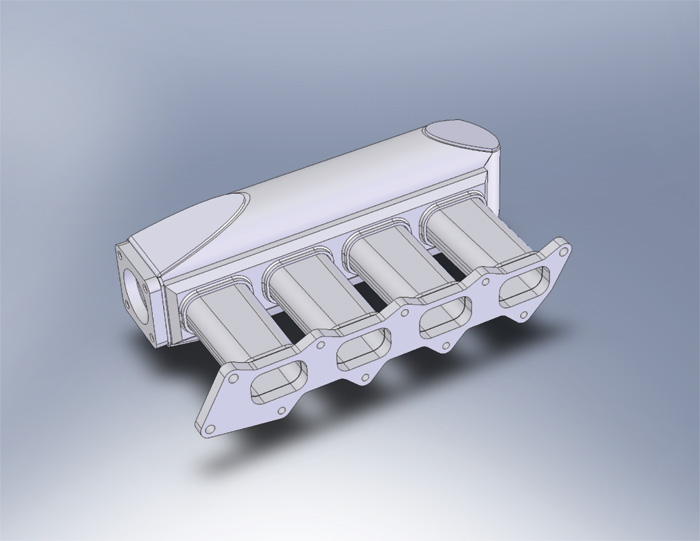
The welds on the manifold are BEEFY, and have full penetration; you will not have any issues with cracking or flexing from this manifold under continuous use! Here are some installed pictures on my 2G Eclipse!
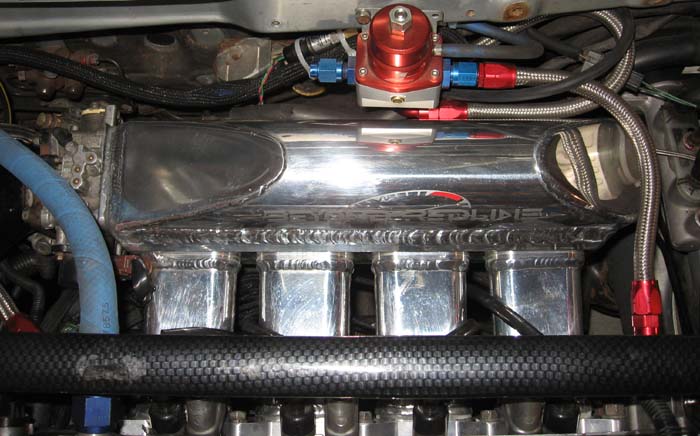
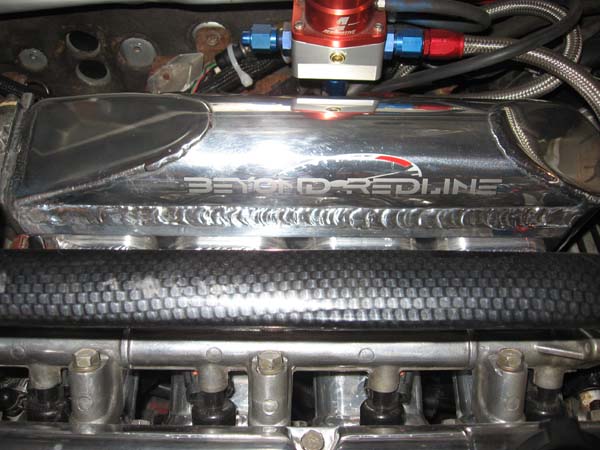
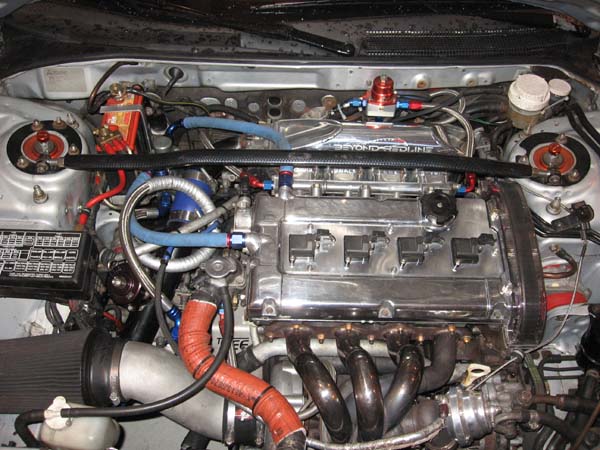
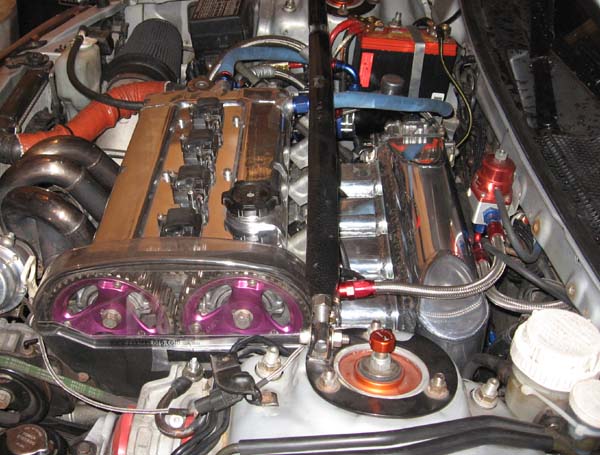

Prior to the production of this manifold for public sale, it was dyno-tested over 100 times on three different vehicles with different setups.
Two of these vehicles are streetcars, and ranged in power of 280-295AWHP before intake manifold installation. The third vehicle was my 1999 Eclipse GSX, which was in the 720-740AWHP range on this dyno with the old intake manifold on 50psi of boost.
This sheet metal intake manifold was originally designed to be used on high horsepower applications with big turbos and big cams, but after all of the dyno-testing results came in, we were AMAZED to see how potent this manifold was over the competitor’s SMIM’s on very street-able applications with SOLID gains and smoother boost response!
Now, on to the dyno results you all have been waiting for!!
*All results are SAE / Uncorrected numbers on a Dyno Jet 424XLC All-Wheel-Drive Chassis Dynamometer. This dynamometer is equipped with the Eddy Current braking system for steady-state-load testing and wideband O2 data analysis.
______________________________________________________________________________________________________________
Car #1: 1G Talon:
Modifications consist of the following:
*Engine: 6-bolt, 2.0L with Eagle rods, .040”-over Wiseco 9.0:1 pistons and BSE kit.
*Head: 1G, Stock un-ported, stock springs and stock camshafts.
*Turbo: SBR GT-11 with TD06 20G compressor cover.
*Exhaust: 3” Turbo-back exhaust.
*Fuel System: Walboro 255HP fuel pump with 680cc fuel injectors.
*Fuel Management: Stock ECU with HKS VPC (650 chip) and SAFC-2.
*Fuel used in tuning: 93-Octane pump gas
*Old Intake manifold: “Brand X”
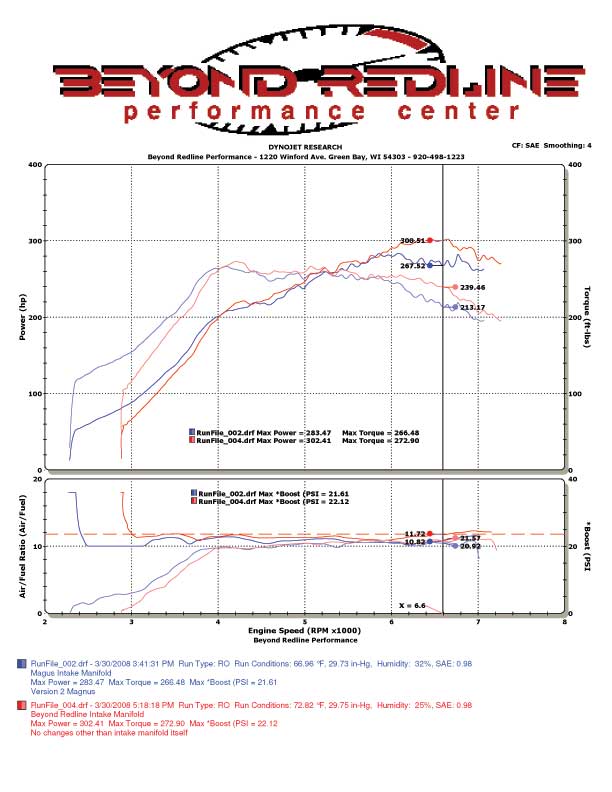
In the dyno graph above, Run #2 (blue lines) is the old SMIM, while Run #4 (red lines) is the Beyond Redline Performance SMIM.
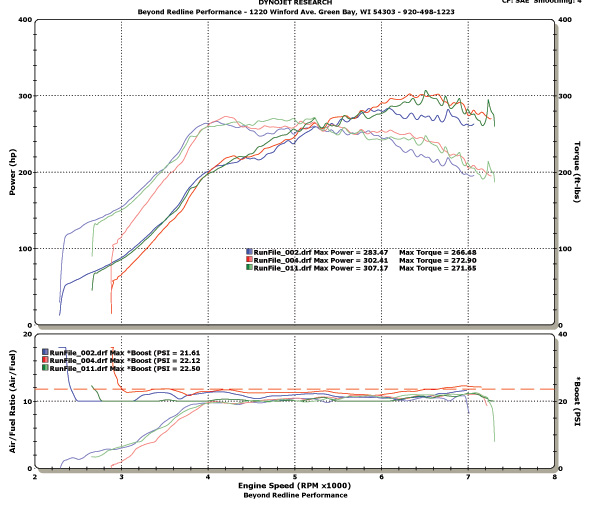
In the dyno graph above, Run #2 (blue lines) is the old SMIM, while Run #4 (red lines) and Run #13 (green lines) are the Beyond Redline Performance SMIM.
Results:
* Power gains from 4000rpms-7300rpms over the leading competitor’s SMIM manifold!
- Peak gain of 19AWHP (6600rpms) and 6Tq (4200rpms).
*** MAJOR gains from 5800rpms-7200rpms of up to 35AWHP (6200rpms-6600rpms) and 25Tq (6600rpms) at the same boost level!
- Smoother boost response was experienced and there was NO turbo spool-up lost with the intake manifold changeover.
- No fitment issues, and no Upper Intercooler Pipe change was required to fit the Beyond Redline SMIM over the Competitor’s “Brand X” manifold.
___________________________________________________________________________________________________________
Car #2: 1G Laser: Modifications consist of the following: (Will be added shortly)
*Engine: 6-bolt, 2.0L with Eagle rods, .040”-over Wiseco 8.5:1 pistons and BSE kit.
*Head: 1G, Stock un-ported, Comp 101200 camshafts with performance springs and lightweight retainers
*Turbo: Forced Performance FP-3052
*Exhaust: 3” Turbo-back exhaust
*Fuel System: Walboro 255HP fuel pump with 680cc fuel injectors
*Fuel Management: Stock ECU with 2G MAF and SAFC
*Fuel used in tuning: 93-Octane pump gas
*Old Intake manifold: “Brand Y”
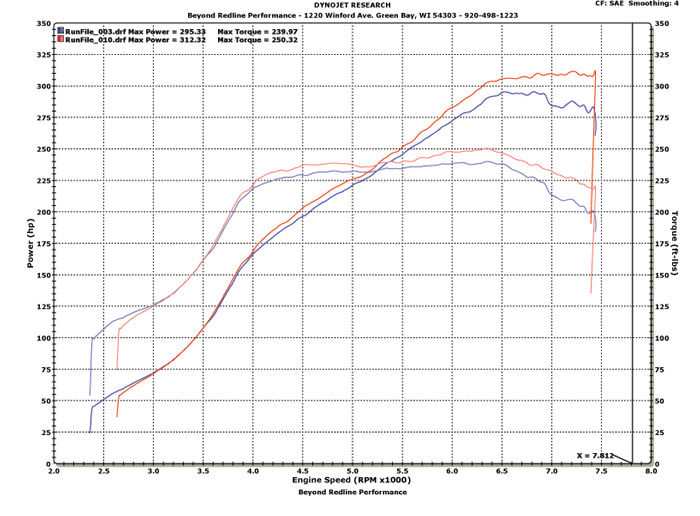
In the dyno graph above, Run #3 (blue lines) is the old SMIM, while Run #10 (red lines) is the Beyond Redline Performance SMIM.
Results:
* Power gains from 3600rpms-7500rpms over the other leading competitor’s SMIM manifold!
- Peak gain of 17AWHP (7400rpms) and 11Tq (6400rpms).
- 5-15AWHP gained from 3500rpms-5900rpms, 15-30AWHP gained from 5900rpms-7500rpms!
- Power did not drop off at 7500rpms!
- 5-15Tq gained from 3500rpms-6900rpms, and 15-20Tq gained from 6900rpms-7500rpms!
- Super smooth boost response was experienced and there was NO turbo spool-up lost with the intake manifold changeover.
- No fitment issues, and no Upper Intercooler Pipe change was required to fit the Beyond Redline SMIM over the Competitor’s “Brand Y” manifold.
___________________________________________________________________________________________________________
Finally, now onto the BIG GAINS!!!
Car #3: Tim’s 1999 Eclipse:
Modifications consist of the following and are extremely abbreviated due to the fact that there is not enough space to simply put them all out:
*Engine: 7-bolt, 2.3L Stroker with Eagle rods and Ross pistons, FFWD Butcher crank, BSE kit.
*Head: 1G unported, Crower single springs and retainers, stock size valves, stock lifters, HKS 272/272 cams, 2.5” IC pipes with a 1G stock throttle body.
*Turbo: Garrett GT4088R with T4 0.95 A/R divided flange
*Exhaust: 3.5”-to-3” Race Exhaust with muffler.
*Fuel System: Dual Walboro 255HP’s (1-in-line/1-in-tank), and 1000cc fuel injectors and –6AN feed line.
*Fuel Management: AEM EMS
*Fuel used in tuning: VP Racing Q16 – 117 Octane oxygenated race fuel
*Old Intake manifold: “Brand X”
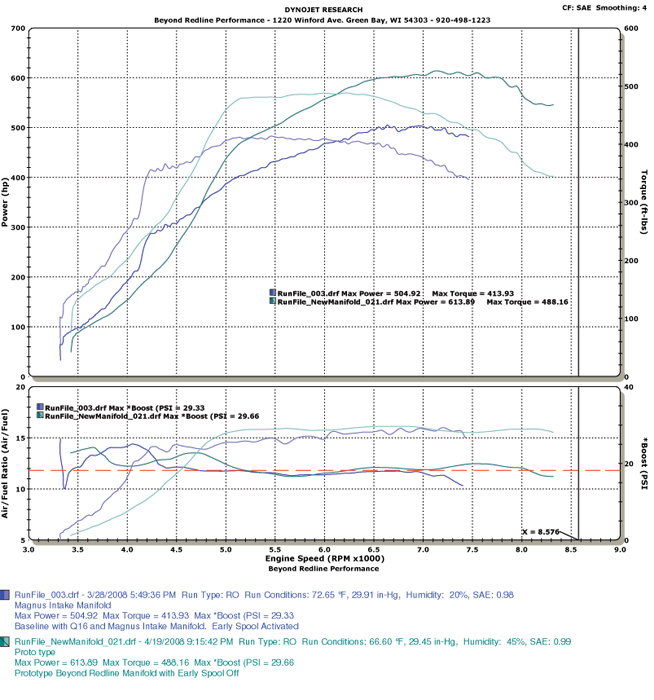
In the dyno graph above, the old manifold (Run #3, dark blue lines) base-lined 504AWHP and 413Tq at 29psi in 3rd gear with early spool-up ignition timing activated. **This is shown in the graph for the spool-up differences in the 3500rpm-4700rpm ranges. ** 29psi is normally reached at 4300rpms-4500rpms with a normal timing map being run.
The Beyond Redline SMIM (Run #21, turquoise lines) put down an extremely impressive 613AWHP and 488Tq at 29psi in 3rd gear with early spool-up turned OFF.
* Full boost was obtained at 4700rpms; Approximately 200rpms of spool up was lost with the new manifold with early spool-up timing retard turned OFF vs. the old manifold with early spool-up turned on.
* Power gains from 4900rpms-8300rpms over the other leading competitor’s SMIM manifold!
*** Peak gain of 109AWHP (7100rpms) and 75Tq (6200rpms)***
- 40-80AWHP gained from 4900rpms-6000rpms, 80-120AWHP gained from 6000rpms-8300rpms!!
* Peak power hit at 6500rpms, and CARRIED all the way to 7900rpms before starting to drop.
-75-100Tq gained from 5200-6000rpms, and over 100Tq gained from 6000-8300rpms!!
* Peak torque hit at 5200rpms, and CARRIED until 6500rpms before starting to drop.
*Extremely stable boost curve throughout the power band!
*Felt much smoother on the street also!
-Several dyno graphs are attached to show the characteristics of this sheet metal intake manifold to show its consistency for power delivery.
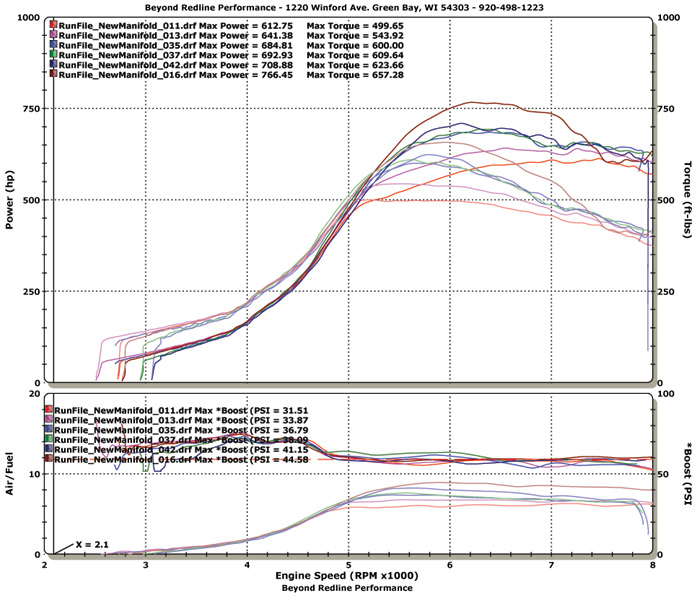
-As well, my old Horsepower record was 740AWHP/696Tq on their old DynoCom dyno at 49psi (peak, dropping to 42psi) in 3rd gear, and on the DynoJet, it base-lined 726AWHP/678Tq at 50psi in 4th gear. The peak numbers on the new Beyond Redline SMIM at a much lower boost of 44psi (peak, dropping to 39psi) put down an amazing 767AWHP/657Tq – ON 6psi LESS!!!!
Unfortunately, I broke WAY TOO MANY PARTS on the dyno this year, and couldn’t provide back-to-back 50psi numbers with the car because the cylinder head destroyed itself after Run #24 due to valve float from dead valve springs. This is evident in the shortened 726AWHP dyno pull due to float; if you look at old dyno results you will find my 740AWHP/696Tq sheet in my photo gallery. We were projecting 800-825AWHP and over 700-720Tq on the conservative side at 50psi.
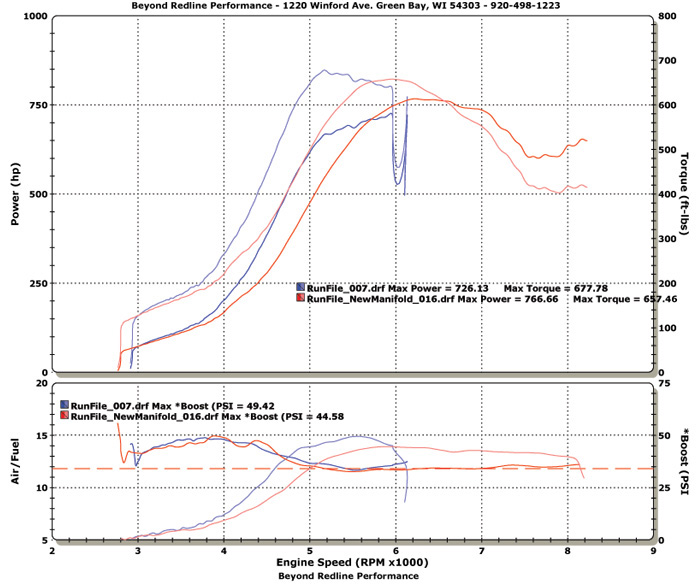
- After this experience, we toned it down a little and did some tests in the 29psi-41psi ranges on a dying turbo (can be seen in the dropping boost levels in the later dyno pulls). With the old SMIM, my power band would drop-off at 7000-7200rpms; now it holds past 8000rpms with solid gains. See the graphs below and notice how smooth the boost is throughout the power band and the consistency of the power curve.
In the two graphs below, you can notice the smooth boost and extremely strong power band from 5000-8000rpms! The top graph is Horse Power, while the bottom graph is showing Torque.
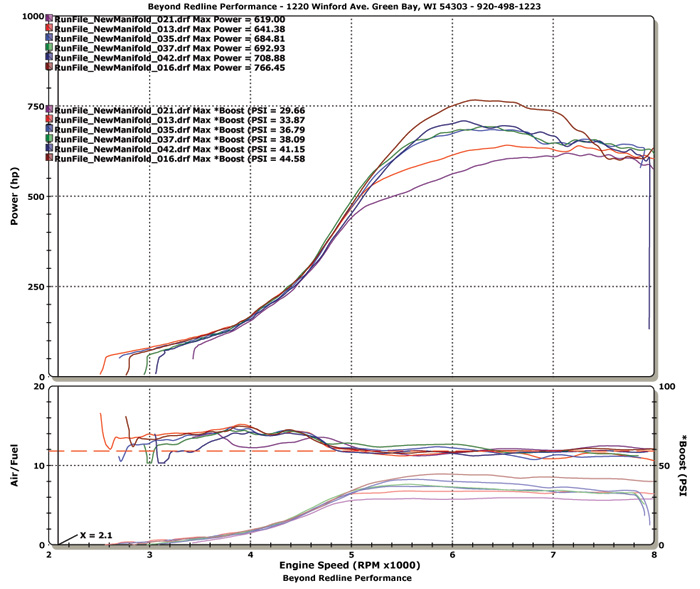
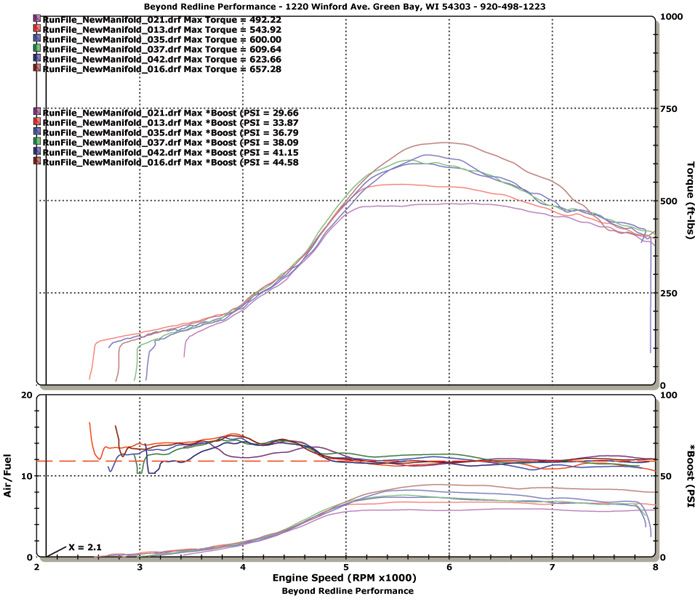
In conclusion to this large volume of dyno results over several vehicles, applications and tests against the two leading sheet metal intake manifold manufacturers for the DSM platform, we were able to produce solid data showing the excellent gains of 5-20AWHP in the mid-range of 3500-5900rpms and gains of 15-35AWHP in the top-end at 5900-7500rpms and 5-20Tq throughout the power band of 4500-7500rpms on mildly to moderately modified cars with a quality tune.
In my heavily modified DSM, this manifold proved to be the BEST modification for huge gains of 40-120AWHP from 4900-8300rpms and 75-100+Tq from 5200-8300rpms over the competitor’s proven SMIM. It proved itself to be extremely consistent, provided extremely smooth boost response and ramp-up, and proved to be much more noticeably smooth on the street and dyno throughout the power band.
The quality and craftsmanship of the product is excellent, along with its fitment in 1G and 2G applications utilizing a 1G cylinder head and a bolt-on Mitsubishi throttle body with minimal modifications when compared to other sheet metal intake manifolds on the market. On a 2G, you will need to flip around the brake fluid reservoir and its two hoses 180-degrees for clearance of the plenum. On a 1G, there were no modifications needed over the other SMIM’s out on the market. Both manifolds require you to relocate your coil pack, or change over to a Coil-On-Plug ignition system – which is what I recommend for ease of installation. As well, I also run an Odyssey PC680 battery in the stock location on my 2G – Upper Intercooler Pipe fitment depends on the application.
For more information and pricing on the Beyond Redline Performance Sheet Metal Intake Manifold, please contact Beyond Redline Performance by going to their website or online store or give them a call.
Homepage: Beyond Redline Performance Center Home Page
Online Store: Beyond Redline Performance Center Online Store
Contact Information: Contact Us at Beyond Redline Performance Center
Currently, this intake manifold is a LIMITED PRODUCTION piece only!!! So be sure to act now before they are all gone!!!
As well, the logo design is different than mine -- it is CNC'd into the plenum sides instead of a cheap little sticker like mine.
I hope that this invaluable technical writeup will help others out there in their quest to find a high quality part that is PROVEN and well designed to handle anything you are going to throw at it! Thank you for your time, and good luck to you all!
Sincerely,
Tim Zimmer
9.96 @ 148mph (At 640awhp/567TQ)
NOW AT: 766AWHP @ 44psi
We'll see what 2009 brings!
New turbo and freshened motor for 2009!
**Disclaimer** I do not work for Beyond Redline – I am only a customer! Please contact them for answers to your questions pertaining to the manifold! **This post is a documented overview of released test data, it is not a testimonial**




